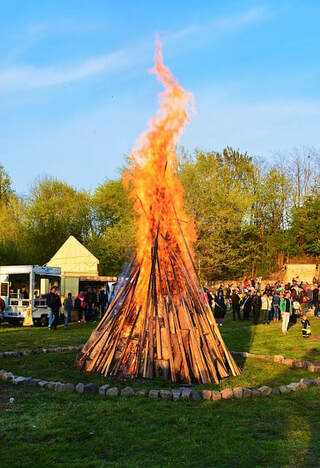Roaring bonfires on a warm spring night, songs of springtime and the end of winter, gravlax and schnapps, white caps and witches – if you’re anywhere in Sweden and Finland on the night of April 30th, these are just some of the things you’ll see, as the entire populace celebrates the ancient festival of Walpurgis Night.
Walpurgis Night: Its Origins and Traditions

Walpurgis Night is celebrated not only in Scandinavia but also in Germany and the Baltic states. The occasion itself is known by many names: Walpurgisnacht in Germany, Vapunaatto in Finland and Valborgsmässoafton in Sweden. The roots of Walpurgis Night are ancient and stem from the practices of long-ago pagans, who celebrated the coming of summer, and the death of winter, on this day. The celebration adopted a more Christian slant with the martyrdom of a German Abbess named Walpurga which took place at around the same time in the eight century.
Many of the traditions associated with Walpurgis Night are strictly local, differing from area to area, or even town to town. Despite all the differences however, there are a few elements which apply without any exception. One of the most striking is the amount of hullabaloo that goes on at night! Rather like Halloween, the idea is that once the sun sets, the people make as much noise as possible in order to scare away the ghosts and spirits. Of course, being required to make a lot of noise really helps set the tone of the whole celebratory atmosphere!
The most widespread tradition of Walpurgis Night, especially in Sweden, is the blazing fire. For the ancient pagans, the fire symbolized the growing strength of the summer sun, around which they would gather to take part in fertility rites and other customs. Though Scandinavia is now staunchly Christian, the fires are still burned and people still gather around the blaze to celebrate the coming of springtime, chatting, drinking - and sometimes engaging in the modern equivalent of fertility rites - until the wee hours of the morning.
The fireside celebrations aren’t for just adults though, at least in the early hours of the night, and at almost every bonfire there’ll be parents and families joining in the festivities as well. The younger celebrants have their own traditions too: modern doting parents often dress up their daughters
in adorable witch costumes for the night, an amusing reversal of ancient customs, as bonfires were also once lit by superstitious farmers to ward off prowling witches looking for livestock to curse! Another popular youth custom, most commonly found in the smaller towns and villages in southern Sweden, is for teenagers to gather greens and branches from the woods at twilight to decorate village houses; As a reward for their labours (and the fun of wandering in the woods at night), the youngsters are paid in eggs.
Another major tradition of Walpurgis Night is the singing. Many of the songs were first written down in the 19th century, and they speak of the joyous welcome of spring and the end of winter. Unlike many traditional tunes elsewhere, these songs were often preserved and passed on by students during their spring celebrations, which accounts for their modern popularity. Students being students though, there are always a few bawdy songs added on to the repertoire! Often the singing begins as serious performances by trained choirs in the evening, progress to impromptu group sing-along sessions later on, and towards the end of the night, end as incoherent bellowing of half-forgotten lyrics.
Of all the traditions associated with Walpurgis Night however, the best known is the truly epic amount of drinking which takes place during the festivities. The traditional drink for the night is mead, an ancient drink brewed from honey. A more modern drink is schnapps, or beer. In a pinch however, anything even vaguely alcoholic will do, and in university towns throughout Scandinavia and the Baltics, the students compete to see who can down the most alcohol throughout the night!
Where To Celebrate Walpurgis Night
Though Walpurgis Night is a region-wide celebration, some towns and areas celebrate it more colourfully than others. In Scandinavia for example, the biggest celebrations are predictably in the capital cities, while in Germany, the celebrations are at their most boisterous in Bavaria. If you’re anywhere in Sweden, it is almost guaranteed you’ll see some form of celebration take place.
Most of the more riotous celebrations will take place in the university towns of Uppsala and Lund, where both current and graduated students participate in events that stretch from the early morning of 30th April all the way til dawn breaks on the first of May, wearing at all times the white cap every student is presented with on their graduation day.
Around the rest of the country, though the festivities are less raucous, they are no less entertaining. As darkness falls on Walpurgis Night, people trickle out of their houses and offices and head to the roaring bonfires on the beaches, in the parks and almost any other place where there’s room for people to gather. In the larger cities, those with space in their gardens have their own little bonfires to celebrate with their friends and family, while for others there are often squares or parks set aside for the night's celebrations. In Stockholm, an annual fireworks display adds a bit more sparkle to the light thrown off from the bonfires, while families in particular head for the Skansen open-air museum, which organizes events for both children and adults during the night.